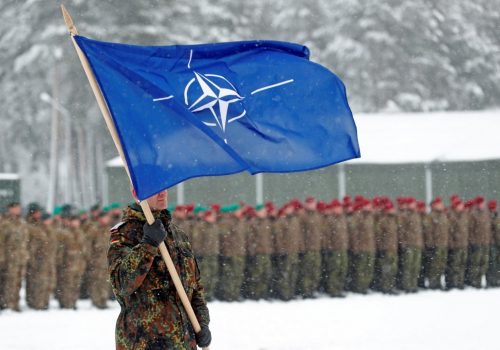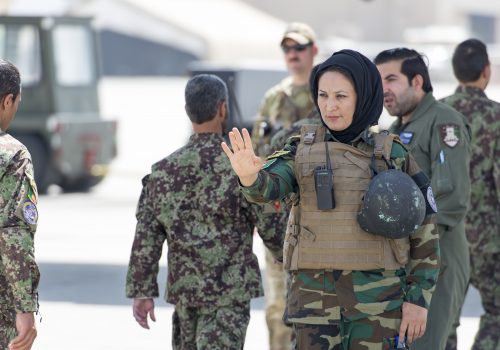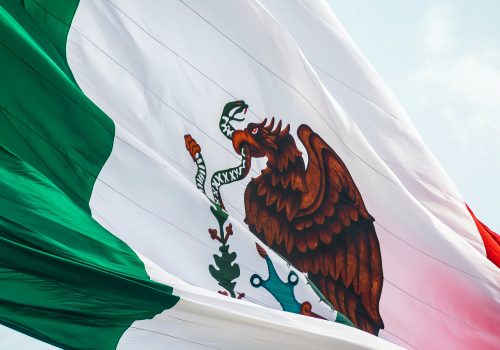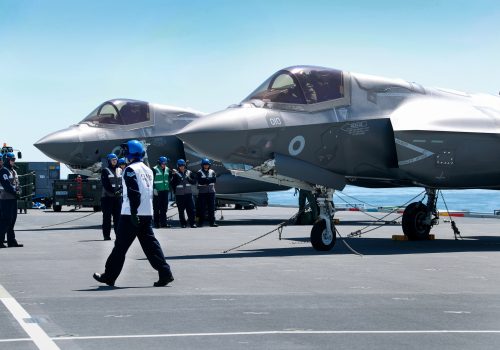Put NATO back in the narrative
NATO is vitally important; but unless you work there, or at the Atlantic Council, you wouldn’t necessarily know that. For those who don’t work for NATO or follow it closely, the organization can seem like an indecipherable blob of bureaucracy and acronyms, a mysterious realm of complicated elite politics, or a major strain on national budgets. The Alliance has a strong and active presence on the European continent. But it has become a political punching bag for the Trump administration, and the misunderstandings about NATO, its mission, and its role in today’s world run deeper than campaign rally rhetoric. To secure its future, NATO must speak to its future—both in terms of its mission and its audience.
To build a multigenerational coalition of engaged transatlanticists, NATO needs to look beyond the students, experts, and practitioners who are already aware of the Alliance and its mission. NATO’s Public Diplomacy Division (PDD) should reach out beyond its current network to the next generation of voters and leaders who often don’t see themselves as direct beneficiaries of the Alliance in the same way people did at the time of NATO’s founding more than seventy years ago and throughout the Cold War. Young Americans in particular, attuned to critiques of NATO in their political discourse and a whole ocean away from all but one other member state, are largely unaware of the impact the Alliance has on their daily lives. NATO should design a long-term, sustainable campaign to tell the story of its success—of what the organization is, what it stands for, and why it’s still relevant in the twenty-first century.
The first step is honing the story itself. For most of the Alliance’s history, the dividing lines between friend and foe were clear. That bipolar system no longer exists—and hasn’t for decades. Since the fall of the Soviet Union in 1991, NATO has tried to redefine its role in the international system with mixed success. Today, when the principal threat to member states comes not from an invasion by foreign troops, but from a global pandemic, climate change, and unattributed cyberattacks, it is more challenging for NATO to promote its core tenet of collective security.
Getting the story right is more than a matter of political necessity or public relations. With the rise of disinformation, digital authoritarianism, natural disasters due to climate change, and a globalized society, younger generations are less concerned with military power as a source of security and instead think about security more holistically, incorporating matters such as civil defense, societal resilience, and technological and digital literacy. National—and transatlantic—security, moreover, no longer refers solely to military operations. It also includes developing and maintaining influence through soft power and tackling a diversity of nontraditional threats. As responsible consumers of information and voters for political leaders whose decisions have consequences for NATO’s collective defense, citizens of all ages and backgrounds have a part to play in addressing these problems.
Just as the terrain where NATO is operating has shifted, so too should its messages. NATO’s StratCom Centre of Excellence, established in 2014, is a step in the right direction. It highlights strategic communication as a vital tool in NATO’s “evolving roles, objectives and missions” and recommends the terms for NATO’s public diplomacy strategies. Unfortunately, these strategies do not go far enough in creative messaging and are too narrowly focused on existing NATO stakeholders. We therefore recommend supplementing existing public diplomacy efforts with three specific ideas for turning millennials and Generation Z into NATO supporters: cultivating the next generation of diverse transatlantic leaders through targeted recruitment efforts; embracing nontraditional storytelling mediums to reach young leaders in non-defense sectors like business, finance, technology, entertainment, and education; and using the relationships NATO has with outside actors to amplify creative messages and track the impact of its outreach.
To be clear, these efforts are not about obscuring NATO’s military purpose, but to recognize that the Alliance’s essence has always been political in nature and focused on securing democracies. Promoting these dimensions of NATO’s mission will resonate better with those outside the Alliance’s traditional orbit.
Watch the video
Cultivating the next generation of leaders
NATO has two opportunities to exploit ready-made tools to share its narrative with the next generation of national security professionals. The first is to tap into existing national military recruitment campaigns that are already adjusting to the fact that young adults have a broader understanding of security. PDD should work with national recruiters in member states to add NATO to their pitches. The military is inherently mission-driven—recruits know why they’re joining and what they are fighting for—and NATO fits into this ethos.
The second opportunity is to cultivate the Young Professionals Programme (YPP), NATO’s new initiative to build its expertise and recruitment base. YPP participants should be required to engage with peers through social media and other platforms to share the behind-the-scenes reality of NATO’s employees and stakeholders. NATO PDD can also connect YPP participants to journalists, government officials, think tanks and nonprofit organizations, and social media influencers to share their experiences through interviews, published essays, question-and-answer sessions, and other nontraditional storytelling formats. This serves two purposes: first, it gives NATO a greater voice among young professionals as they decide on career trajectories. Second, these storytelling methods allow NATO to broaden its future candidate pool, leading to increased diversity that will make the Alliance stronger, nimbler, and more responsive to crises.
Embracing nontraditional storytelling methods to reach new audiences
While enhancing recruitment is key, it is equally important for NATO to rethink its outreach strategy. At the moment, NATO is deeply involved in curating new methods of engagement with existing stakeholders through efforts like the #WeAreNATO social media campaign, the Atlantic Council’s #StrongerWithAllies hashtag, and dynamic elements of the #NATO2030 campaign such as the video contest. But how far does NATO reach beyond the bubble of transatlantic policy wonks? Do young people in other sectors understand the value of NATO? In the past, NATO was a core part of the lives of people across sectors because conflict with the Soviet Union overshadowed all other national security concerns. Now, young professionals outside of the policy world—even those in sectors that are integral to combatting the security challenges of this century—are not as engaged in national security debates. More importantly, they are voters who elect the leaders making decisions on foreign policy, appropriations, and defense priorities.
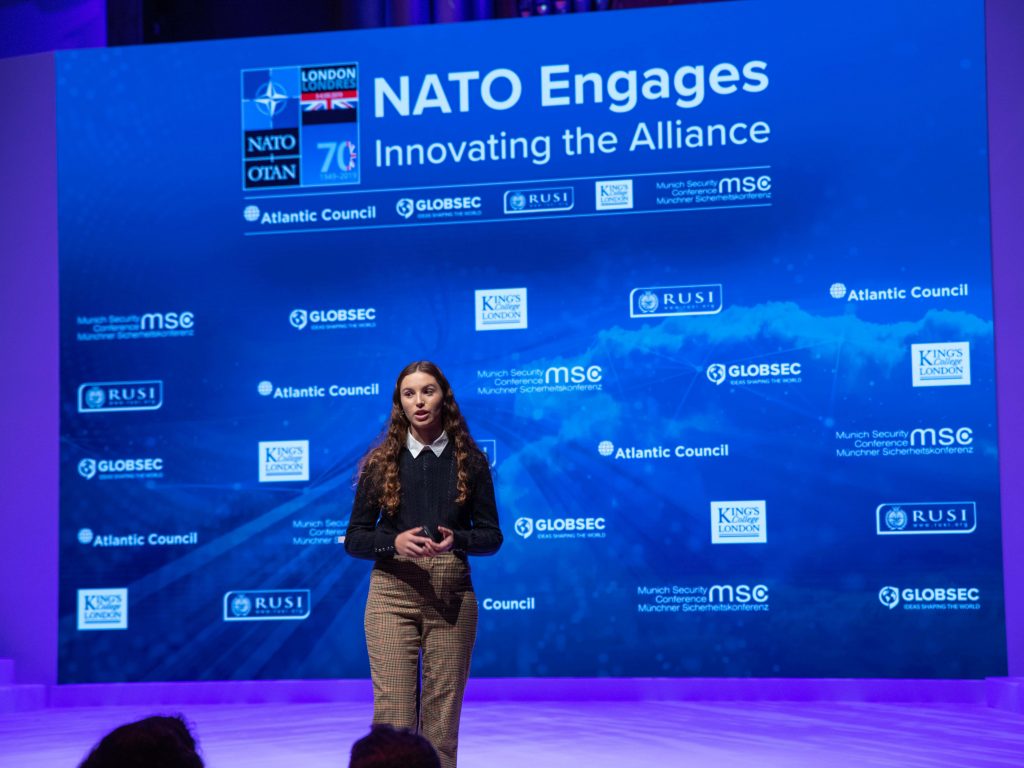
Now, young professionals outside of the policy world—even those in sectors that are integral to combatting the security challenges of this century—are not as engaged in national security debates. More importantly, they are voters who elect the leaders making decisions on foreign policy, appropriations, and defense priorities.
Olivia Seltzer, editor of The Cramm, speaks at NATO Engages London. (Source: Atlantic Council)
If NATO is to remain relevant, it has to convince young leaders across professions that it is dynamic and responsive to modern threats, as NATO Secretary General Jens Stoltenberg did recently during an event dedicated to NATO’s role in combating climate change. In short, NATO needs to go on a charm offensive. To that end, there are a slew of creative methods to tell NATO’s story to new audiences, including:
- Bringing the archives to life: NATO has painstakingly collected and made available to the public decades of historical records, memos, and documents that are full of rich stories from its past. By partnering with historians, librarians, and other archival specialists, NATO has constructed a comprehensive visual history. Now, NATO should tap into its next-gen talent pool to bring the archives to life. Building on the boom in “aesthetic” social media accounts, NATO should launch “NATOcore” (a Gen Z term for “superfan”) Instagram, TikTok, and Twitter accounts. Emphasizing engaging visuals paired with informational text can pull in a wider audience who may not have known how to find these documents and stories on their own.
- Bringing the organization to life: For many young people, NATO may seem like an unwieldly international organization run by older, military people with whom they do not share life experiences. Making the Alliance more than a faceless bureaucracy is critical to combating this perception. To that end, NATO should seek out online magazines, publications, and other media opportunities with millennial and Gen Z audiences to introduce the Alliance’s missions, values, and people through interviews and photo essays.
- Bringing the nonmilitary dimensions of NATO to life: Specifically, NATO can project itself as a dynamic organization of people from all walks of life by highlighting its nonmilitary staff. NATO has an incredible corps of engineers, programmers, accountants, legal practitioners, and information technology professionals who are integral to the organization’s success. NATO should highlight these individuals in trade publications and magazines—and leverage influencers in these fields—through interviews, essays, videos, and other media that will reach beyond the military domain.
Using outside actors to amplify creative messages and evaluate outreach
Vitally important to this endeavor of turning millennials and Gen Z into NATO supporters is a network of actors that fall in between established NATO stakeholders and those uninitiated with the Alliance. Beyond direct outreach efforts to younger citizens, NATO must use heads of state and government, other elected officials, and academic and think tank partners to serve as positive influencers of the NATO brand. These actors have large constituencies and established methods of outreach that can be tapped to reach audiences more efficiently than NATO can achieve directly.
NATO might also employ politicians, research organizations, and consulting firms with the technical ability to collect data to assess the effect of outreach efforts. Where successful, NATO can use such data to demonstrate to member states that creative, innovative storytelling methods are worth the time and money because they expand the base of support for the Alliance.
Endgame
There are direct parallels to the effort we describe in other areas of international relations. The world of international development was transformed in the 1980s and 1990s by the realization that if it was to succeed, it needed support and understanding way beyond its professional base. Humanitarian aid, support for refugees, and assistance to those living with HIV/AIDS have all been the topic of large-scale coordinated public campaigns that engaged younger people worldwide. These campaigns stemmed in part from a realization that these could not remain issues that engaged only those disposed to support aid: younger generations needed to be engaged as well.
For NATO, the challenge is reframing the messaging as well as changing the delivery. Security is being redefined, whether by hybrid warfare, disinformation, climate change, energy security, or the rise of new world powers with authoritarian strategies that reach beyond their borders. Young people are aware of these issues, but NATO’s relevance in tackling them has not been made clear to them.
NATO should work to gain the understanding and support of younger generations that rely on the latest forms of communication, place a premium on transparency, don’t automatically defer to experts or politicians, and won’t be taken for granted. This effort should also be about ensuring that NATO itself changes the way it thinks about security and what it means—moving from the language of battlefields and committees to focus on highlighting the outcomes for citizens, voters, workers, and families.
This effort should also be about ensuring that NATO itself changes the way it thinks about security and what it means—moving from the language of battlefields and committees to focus on highlighting the outcomes for citizens, voters, workers, and families.
To remain effective, NATO must engage the generations that are stepping into leadership roles. Policy and public diplomacy are a two-way street. NATO needs to use public diplomacy to understand which policies matter to future leaders across sectors and pursue those policies such that there is a broad coalition of support for the Alliance across sectors, urban and rural areas, generations, and political affiliations.
This must start with new and creative storytelling methods. NATO must clarify how it advances a holistic view of national security, explain its relevance in the twenty-first century, and, most importantly, demonstrate how younger generations fit into its present and its future.
* * *
Bridget Corna is the assistant director for Digital Engagement at the Atlantic Council.
Livia Godaert is the assistant director with the Future Europe Initiative at the Atlantic Council.
Explore the podcast series
Related NATO 20/2020 essays
Related program

The Transatlantic Security Initiative, in the Scowcroft Center for Strategy and Security, shapes and influences the debate on the greatest security challenges facing the North Atlantic Alliance and its key partners.
Subscribe for events and publications on transatlantic security
Sign up for updates from the Atlantic Council’s Transatlantic Security Initiative, covering the debate on the greatest security challenges facing the North Atlantic Alliance and its key partners.
Image: NATO Secretary General Jens Stoltenberg speaks at an event co-hosted by the Atlantic Council and the German Marshall Fund of the United States to launch NATO’s #NATO2030 initiative. (Source: NATO)
